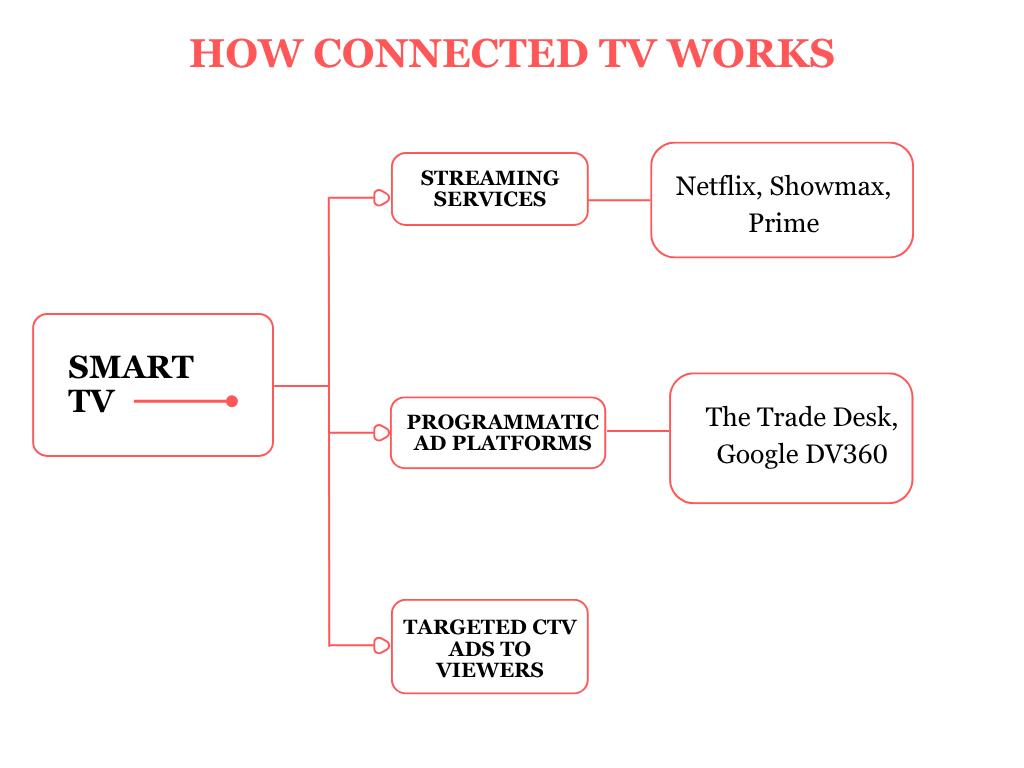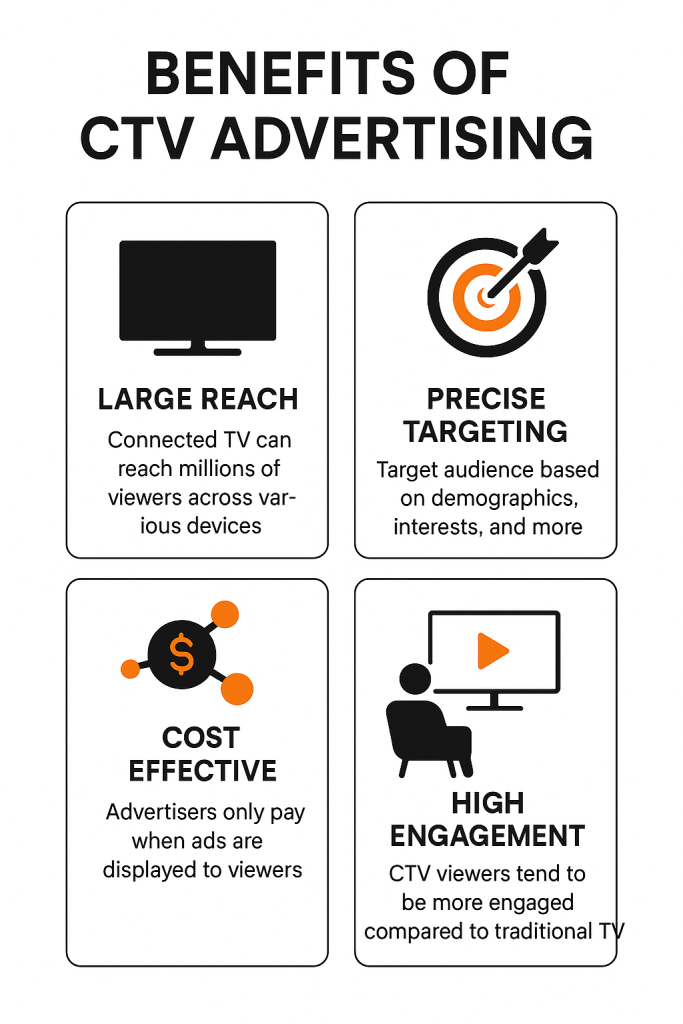The way people watch TV has changed. But the way many brands advertise hasn’t.
As audiences shift from traditional cable to streaming platforms, the most powerful screens in the home, the TVs, are still very much alive.
And in the process, it’s taken everything brands love about video advertising: sight, sound, and story and merged it with what they now demand from modern marketing: data, targeting, and control.
This hybrid space is known as Connected TV (CTV). It blends the immersive power of traditional TV with the precision of digital, allowing businesses to reach real audiences on the biggest screen in the home through streaming platforms like Hulu, PlutoTV, and Paramount+.
Connected TV (CTV) is where television meets the ever-evolving satisfaction of the consumer. In this blog, we’ll break down what Connected TV is, how it works, and why it’s quickly becoming one of the smartest tools in a modern marketing strategy, especially for brands and companies with global ambitions.
What is Connected TV?
Connected TV (CTV) refers to any television that is connected to the internet and streams content through apps, rather than traditional cable or satellite services. This includes:
- Smart TVs (e.g., Samsung, LG, Sony)
- Streaming devices (Roku, Amazon Fire TV Stick, Apple TV)
- Gaming consoles (PlayStation, Xbox)
CTV vs OTT: What’s the difference?
You’ll often hear OTT (Over-The-Top) mentioned in the same breath as CTV. They are similar and, like siblings, usually mistaken for each other.
Here’s the difference between the two:
- OTT refers to the content delivered via the internet (e.g., Hulu, Prime Video)
- CTV refers to the device it’s watched on, the internet-connected television
CTV is the screen; OTT is the stream. And together, they’ve transformed TV from something you watch passively as a viewer into a weapon used by businesses to target viewers and measure metrics.
Recommended read: 7 Outstanding Google AI Search Features from Google Marketing Live 2025
How Connected TV Advertising Works
CTV advertising enables brands to place video ads within streaming content, similar to traditional TV commercials, but with enhanced control and deeper insights.
Ads can appear:
- Before a show (pre-roll)
- During natural breaks (mid-roll)
- After the content ends (post-roll)
But unlike traditional TV, CTV advertising is data-driven. It lets you:
- Target viewers by location, language, interests, or household type
- Choose platforms (Hulu, PlutoTV, Paramount+, etc.) where your audience already watches
- Track performance metrics like impressions, completion rate, and device type
The result is full-screen, non-skippable, premium ad placements that are as effective as, if not more than, the broadcast media or digital media.

Why CTV is Gaining Momentum Fast With Businesses
This isn’t a niche channel anymore. CTV is mainstream, and the data proves it:
- 70.6% of U.S. TV households now own smart TVs, up from 62.3% just two years ago
- Streaming accounts for 46% of total TV viewing in the U.S., surpassing both cable and broadcast
- U.S. CTV ad spend is projected to reach $33.35 billion in 2025, with continued double-digit growth into 2028
So what’s fuelling this growth?
- Changing viewer habits: More people stream content nightly than scroll on socials.
- Improved targeting: Unlike cable, CTV lets advertisers choose exactly who sees their message.
- Better outcomes: advertisers are reporting higher completion rates, brand lift, and viewability on CTV than on other digital channels
Why This Matters for Your Brand
Every shift in media presents two types of brands:
those who react to disruption and those who plan for relevance.
CTV is no longer just “another channel” but a part of a bigger story about attention, trust, and how people choose to engage with content today. For brands in both the U.S. and Africa, it offers distinct opportunities if used strategically. If you’ve built your business on Meta or Google ads, you’ve likely noticed:
- CPMs are rising
- Feeds are saturated
- Engagement feels harder to sustain
Connected TV helps you escape the scroll and appear in a more premium, trustworthy context—the living room. It gives your brand:
- A “big brand” feel without big brand costs
- A presence on the same screen as Netflix, CNN, and YouTube TV
- Precise targeting by demographic, region, or interest
It’s about diversifying with media that holds attention longer and builds stronger brand perception.

Interested in knowing more about your customer behaviour? Read about the Importance of Market Research in Understanding Consumer Behaviour
For Brands Reaching the Diaspora
If you’re running a brand in beauty, fashion, wellness, or consumer goods, you’ve likely built growth through social channels. Facebook and Instagram gave you early traction. But lately, you might have noticed:
- Your costs per click are climbing
- Your reach is throttled by platform changes
- Your content gets buried, even when it’s excellent.
CTV allows you to:
- Reach diasporas in key North American cities by postal code or cultural content
- Target them while they watch trendy movies, sports, or cooking shows.
- Establish trust by appearing on prominent U.S. mainstream platforms.
Additionally, with programmatic buying, you can track exactly how many people view your ad, how long they watch it, and what type of device they use.
In other words, CTV offers the visibility of TV with the measurability of digital.
CTV doesn’t replace social, but it solves a different problem: it gives you visual real estate that feels established, premium, and undistracted. When your ad plays on Hulu or Paramount+, you’re borrowing credibility from the shows and platforms your audience already trusts.
And you can do that with far more control than traditional TV ever allowed. You set the audience, choose the budget, and track the impact.
This is no longer out of reach for your brand. In fact, it’s one of the few places left where visibility still feels earned.
Diaspora customers often feel disconnected from ads that weren’t built for them, especially when those ads appear on platforms where local context is missing.
With CTV, you can:
- Deliver ads that blend familiarity with authority
- Choose streaming environments where they’re actively engaged
Recommended read: Digital Marketing Trends 2025 | Insights for African SMEs
Final Thoughts
The media world has shifted. Attention has moved from cable to streaming, from passive viewing to personal curation.
Connected TV sits at the heart of this evolution, combining the storytelling power of traditional TV with the targeting and tracking capabilities of modern digital.
If your brand is serious about visibility, perception, and ROI, CTV might just be the answer.
Want to Learn More?
Or speak with our media team about starting your campaign: Book a CTV Strategy Call with Pandora
FAQs
What’s the difference between OTT and CTV?
OTT refers to streaming video content delivered over the internet. CTV refers to the actual TV devices (Smart TVs, Roku, Fire TV Stick) used to view it.
Can small or mid-sized businesses use CTV?
Yes. Thanks to programmatic technology and agencies like Pandora, CTV campaigns can start at $500; no seven-figure media deals needed.
How does CTV compare to social media ads?
Social ads are often short, skippable, and scrollable. CTV ads are longer (15–30 seconds), non-skippable, and watched on a full screen, often in family settings. CTV complements social ads but generally drives better attention and brand lift.
Can I reach diaspora audiences specifically?
Absolutely. Pandora Agency offers diaspora-focused targeting, enabling you to serve ads in specific cities, zip codes, or cultural content spaces where African audiences are most active.



Leave a Reply